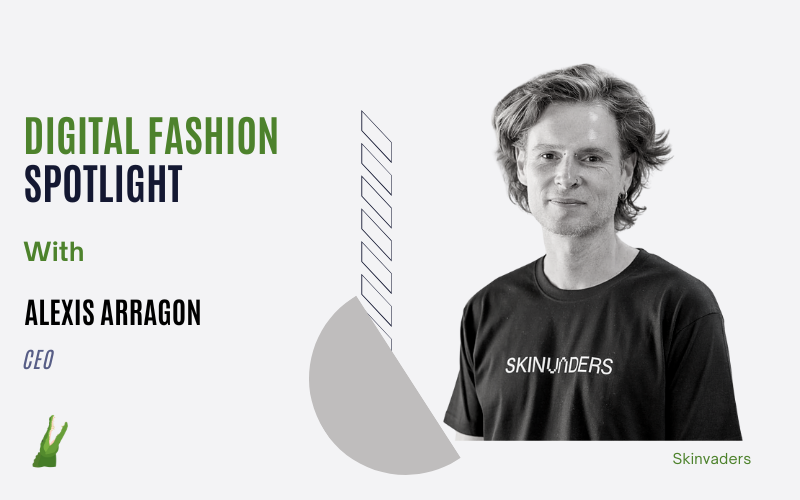With the advent of virtual gaming and metaverse platforms such as The Sandbox, Decentraland, Roblox, Fortnite, and ZEPETO, major brands and companies have been extending their brand positioning to target new demographics on these platforms.
Just as fashion plays an integral role in self-expression for human beings in real life, avatars in the virtual world do the same with digital fashion. According to Morgan Stanley, the digital fashion market could reach $50 billion by 2030.
Several digital fashion platforms have entered the market over the last year to create outfits for avatars and allow users to buy and sell digital apparel. Skinvaders, a third-party platform for fashion labels and brands to digitize their collections, is one of them.
Skinvaders powers Gen.G x PUMA’s new lifestyle fashion collaboration, which recently dropped on ZEPETO. Following that, we speak to Skinvaders CEO Alexis Arragon for more insights into the digital fashion market and what it means for 3D artists and fashion designers.
Please tell us about yourself and the story behind Skinvaders.
I’m a game industry/3D veteran. I started programming when I was 12, and went on to study Japanese and Computer Graphics in order to design games.
Eventually, I fell in love with the topic of virtual fashion. I started looking at virtual fashion three years ago, way before NFTs and the Metaverse were even a thing. Skinvaders was born as a bridge between fashion brands and video games, and now we’re working with a dozen brands to produce and distribute their virtual collections in different virtual worlds, web2 and web3.
What piqued your interest in the Web3 space and where did you first hear about it?
I first heard about the world of DeFi after being interested in crypto, browsing projects on the different chains and trying to make sense of it all.
For the longest time, I remained sceptical about NFTs but the whole DAO thing really got my attention: the simple fact that you could let your community, your audience, decide for your brand within a constrained framework seemed like a great opportunity to trial new products.
I’m still amazed that so few fashion brands (if not any) used this to spearhead digital collections.
Several digital wearable platforms have popped up over the last year. What sets Skinvaders apart from the rest?
There are a LOT of digital wearable platforms and marketplaces out there nowadays. I think it’s safe to say that Skinvaders is one of the only—if not the only one—that’s focusing on a critical aspect: production at scale. Creating 3D content and, specifically, fashion content is hard.
Creating a car in 3D is already challenging, but a jacket that needs to fit a specific avatar, move and stretch in all directions, that’s even more difficult! We’ve seen so many marketplaces trying to offer content, but the real bottleneck is in gathering the right artists to produce it.
What does the metaverse and digital wearable market mean for the creativity of fashion designers?
Ultimately, it’s not the same thing! On one hand, you have fashion designers. Eventually, some of them get trained to design in 3D, but they do it thinking in terms of pattern making, draping and so on. On the other hand, you have 3D artists and character designers who are modelling outfits for games. Those are two completely different worlds that started to wonder about how to communicate with each other because of fashion brands’ activation in video games.
But, it’s not straightforward for a fashion designer to understand the metaverse and wearable market constraints and vice-versa. We’re seeing changes though, curious people on each side are getting more comfortable with learning about one another, and with more and more opportunities offered by virtual worlds and virtual garments, I’m sure we will see more fashion designers training themselves to produce 3D content, and 3D artists being more interested in fashion design.
Ultimately, I want to see schools tackling both expertises and training 3D fashion designers.
Could you tell us more about the process of designing and replicating digital wearables vs physical apparel?
Physical apparel is crafted by fashion designers, pattern makers and textile specialists; they’re collaborating together to make a physical product. Contrastingly, digital wearables are made by 3D artists who model polygons usually after a photo of a real product.
What are some of the technical and legal constraints when it comes to creating digital wearables?
When creating digital wearables, you’re usually building for a specific platform (ZEPETO, Roblox, etc.). Each platform has its own technical and legal rules, so you have to master all the rules of all the platforms if you want to offer a large panel of options to your clients.
Besides using the metaverse as a marketing tool to reach a wider audience, why do you think a growing number of fashion brands are jumping into Web3?
There are hundreds of millions of users each day on platforms such as Roblox or Fortnite. Brands finally realised those levels of audience volume are unmatched!
What are the most challenging aspects of your role at Skinvaders and how do you overcome these challenges?
The market around digital fashion and wearables is still very new, it’s changing very quickly and very frequently. As the space is ever-evolving, it’s essential to keep abreast of the latest trends. This means we have to be as quickly reactive as possible while maintaining high-quality standards in our work, because we’re representing very famous brands.
What can the Web3 space expect from digital fashion platforms in the coming years and what else can people expect from Skinvaders this year?
Brands have started to take the opportunities around the metaverse quite seriously. Once they realise they can get much more adventurous in terms of concepts and creativity in that space, we will start to see really cool things happening…
What do you think about the current state of the metaverse? What kind of role is Skinvaders playing in it?
Video games are leading the way in terms of interactive experiences that can be played by millions of people while being a commercial success and becoming part of pop culture. We advise our clients to think along those lines when they’re considering “being in the metaverse”.
Where do you think we could see digital fashion in the near future?
When brands start designing in 3D, hopefully, we will see more transversal use cases with assets being reused at different stages of the value chain.
Right now, activations in the metaverse are marketing projects, and maybe some brands are also doing R&D in 3D product design. But those two ends of the fashion value chain do not speak to each other, while they really should. Ultimately a 3D version of any fashion item will be produced by the design team very early on, and reused at different stages of the chain so that it becomes a transversal asset – just like a runway look is shown on stage but also in an ad campaign.
Any other Web3-related industry issue you would like to talk about?
A legal framework for NFTs! Blockchain technology is great, but the NFT world is still somewhat shaky. It’s a tremendous opportunity for brands, as it’s the perfect extension of their consumer base into the metaverse.
But, brands are very cautious about their IP, and the lack of any legal framework for NFTs makes it harder for them to engage in web3 projects, and for consumers to have a sound and stable reference in terms of usage rights.
Stay up to date:





